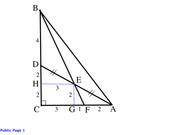Aman verma wrote:
In triangle ABC, D is the mid-point of BC and E is the mid-point of AD. BF passes through E. What is the ratio of AF : FC ?
(A) 1:1
(B) 1:2
(C) 1:3
(D) 2:3
(E) 3:4
VERY tricky question. I'd say it's skirting the 800 level of difficulty!
Here's a solution with some diagrams.
First, we'll add the given information.

Next, from point D let's add a line that's PARALLEL to BF

This addition of a parallel line allows us to see a variety of equivalent angles (and similar triangles!)

First, let's examine these two similar triangles.

Since side AD (on the blue triangle) is twice the length of side AE (on the red triangle), we can conclude that the blue triangle is
twice as large as the red triangle.
So, side AP is twice the length of side AF.
This tells us that
side PF = side AF
Now let's examine these two similar triangles.

Since side BC (on the purple triangle) is twice the length of side DC (on the green triangle), we can conclude that the purple triangle is
twice as large as the green triangle.
So, side FC is twice the length of side PC.
This tells us that
side PF = side PC
At this point, we know that
side PF = side AF and
side PF = side PC
Since both equations are set equal to PF, we can conclude that
AF = FP = PC
So, the ratio of AF : FC = 1:2
Cheers,
Brent







